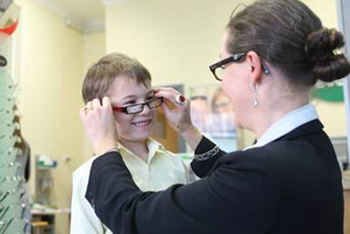Children Labelled 'Problem Learners' May Need Eye Test

Children Labelled -Problem Learners' May Need Eye Test
Specsavers is urging parents to watch their kids for signs of poor eyesight once they're back at school.
According to Specsavers' Optometrist and Managing Director, Peter Larsen, more than 60% of children who are -problem learners' have been found to suffer from undetected vision problems.
'Almost two thirds of children who struggle with learning have undiagnosed vision problems, meaning the solution could be a simple as a pair of glasses," he said.
'Around 80% of everything a child learns is through their vision, so good eyesight is one of the most important tools for their learning and development.
'Misdiagnosis means the underlying vision problem is not addressed and the child may continue to struggle with learning and fall behind their peers. This could result in the child being labelled incorrectly as having a learning difficulty, which could have a major impact on their confidence and their perception about what they're capable of achieving throughout their lives."
Mr Larsen said undetected vision problems were estimated to affect approximately one in four Australian children, while around one in six Australian children wear glasses or contact lenses to correct their sight.
'Even basic issues with their sight can have a profound impact on children but some conditions require swift intervention," he said.
'For example, if a child has a squint, it can be treated relatively easily if caught early on but after the age of seven or eight, the likelihood of needing surgery increases dramatically.
'It is extremely important that a child's eyesight is checked regularly. After eight is often too late because after this age it is much harder to correct any vision problems which may have developed."
There are a number of tell-tale signs that a child may experience vision difficulties. Some signs to look out for include:
Reading problems: Children who frequently skip lines or lose their place while reading books may have vision problems.
Squinting: If a student is frequently squinting at the blackboard, they may be trying to compensate for their poor vision.
Sitting too close to the television: Short-sighted children generally have clear vision at a close range and poor vision at a distance.
Rubbing eyes and headaches: If your child rubs their eyes excessively or complains of headaches regularly, it may mean their eye muscles are fatigued from straining.
Clumsiness: Children might have trouble realising how close or far away objects really are. Sometimes young children who do not walk well actually have problems with their vision.
Behaviour: Some children who have vision problems appear to have a short attention span and may misbehave due to frustration.
Some common eye problems that can occur amongst young children include, long or short sightedness, astigmatism, which results in distorted vision, colour deficiencies and lazy eye.
Specsavers recommends children should have their eyes tested at least every two years from the age of three, and is urging parents to book an eye test to ensure nothing is impeding their child's vision and consequently their ability to learn.
Information from: Optometrists Association Australia
MORE



